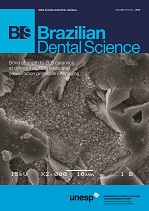Analysis of orthopedic treatment of skeletal Class III malocclusion with Rapid Palatal Expansion and Face Mask therapy
DOI:
https://doi.org/10.14295/bds.2019.v22i4.1794Abstract
Aim: To demonstrate the main effects on maxillary and facial profile after treatment with expansion and face mask therapy in patients pattern III Class III. Material and Method: A cross-sectional study of maxillary expansion and reverse traction performed in 4 patients with maxillary deficiency, in the pre-peak pubertal growth stage and in the mixed dentition, with cephalograms before and after treatment, using angular measurements (SNA, SNENA, ANL and 1NA) and linear (S’-ENA, S’-A, 1-NA, OVERJET, S-LS and S-LI) and plot overlays. Results: Improvement in overjet was observed, going from negative to positive in all cases treated with incisor uncrossing, although it was not statistically significant. The upper and lower labial posture with respect to the base of the nose and the ment improved significantly, represented by the measurements S-LS and S-LI, with a change from the concave profile to slightly convex. Conclusion: Class III malocclusion with maxillary deficiency treated with rapid maxillary disjunction and reverse traction with facial mask was effective in both groups, with maxillary protraction and shifting in the concave to slightly convex profile.
Keywords
Facial Mask; Rapid maxillary expansion; Class III.
Downloads
Downloads
Additional Files
Published
How to Cite
Issue
Section
License
Brazilian Dental Science uses the Creative Commons (CC-BY 4.0) license, thus preserving the integrity of articles in an open access environment. The journal allows the author to retain publishing rights without restrictions.
=================




























